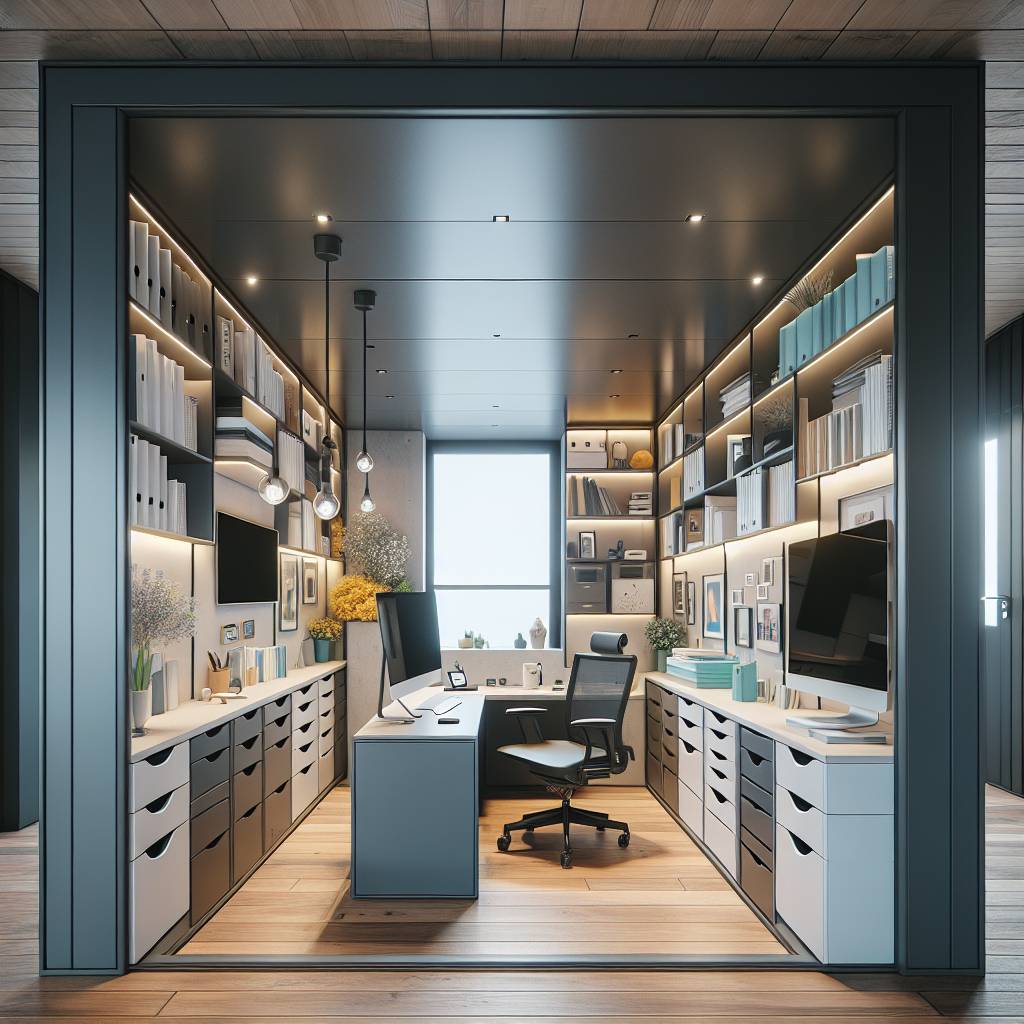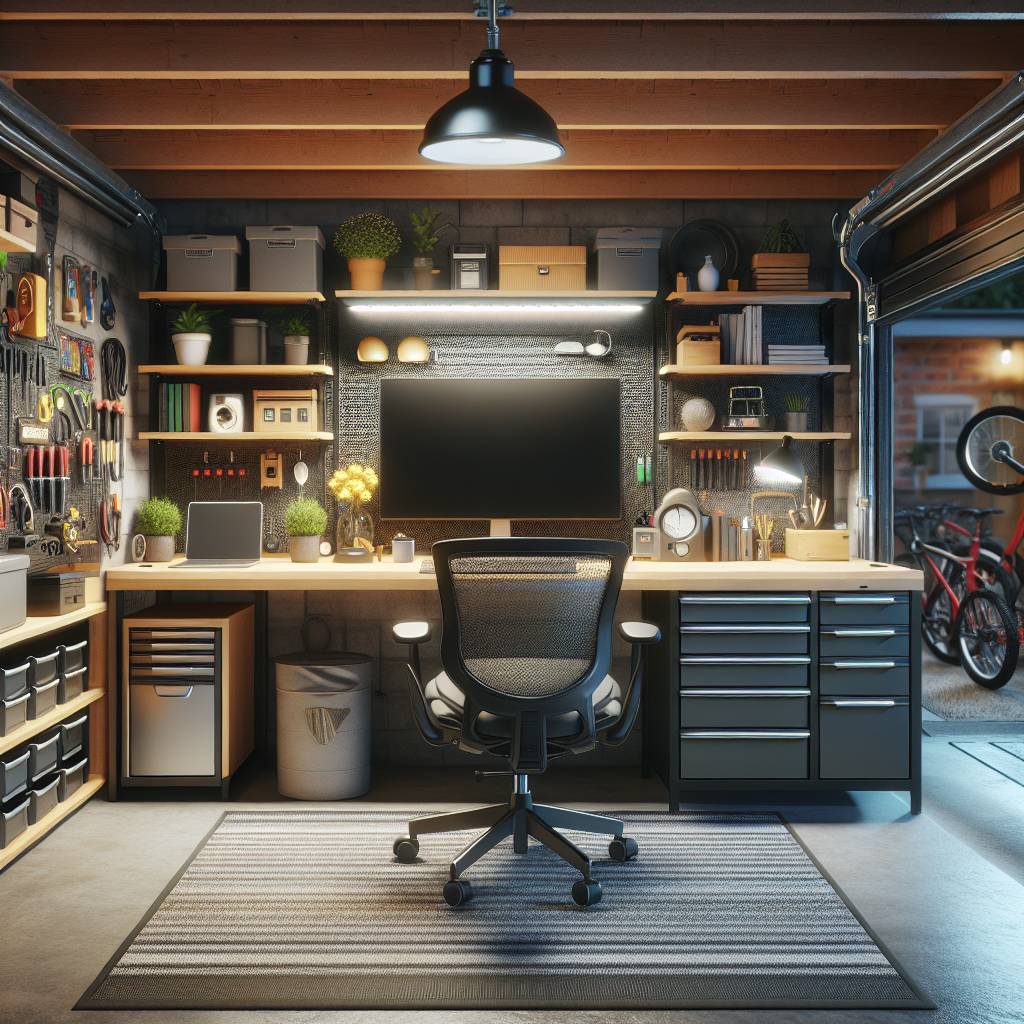Transforming a limited garage space into an ergonomic office and workshop is no longer just wishful thinking. With the rising trend of remote work, maximizing every inch of available space has become essential. This blog post delves into the practical strategies and innovative solutions for creating a functional and comfortable workspace within the constraints of a garage setting.
As we navigate through this guide, we’ll explore ingenious ways to optimize storage, lighting, and furniture arrangements tailored specifically to compact areas. We will discuss how historical industrial design concepts can be repurposed to suit modern-day ergonomic needs in the office space. By embracing these insights and tips, you can revamp your garage into an inviting office environment that promotes productivity while seamlessly blending with your home’s overall aesthetic.
Key Takeaways
- Maximize the potential of your garage space by carefully planning the layout and considering essential furniture selection to create an ergonomic and functional office.
- Prioritize an ergonomic workstation setup to ensure comfort and productivity, including adjustable desks and supportive chairs.
- Optimize lighting and ventilation to create a comfortable and well-lit workspace, considering natural light and proper air circulation.
- Pay attention to flooring and insulation to enhance comfort and reduce noise, ensuring a conducive work environment.
- Implement security and privacy measures to safeguard your workspace, considering smart locks, cameras, and window coverings.
- Consider climate control strategies to regulate temperature and humidity, creating a comfortable working environment year-round.
Garage Office Potential
Space Evaluation
When designing an ergonomic office in a limited garage space, it’s crucial to start by assessing the available square footage. Consider the dimensions of the room and take note of any potential constraints that might affect your design choices. Pay attention to the ceiling height as this will determine your vertical space utilization. Evaluating existing natural light sources is also essential as it can impact both the aesthetics and functionality of your workspace.
To make the most out of a limited garage space for an office, prioritize functionality over aesthetics. In a confined area, it’s important to create a clutter-free and organized workspace that maximizes efficiency and minimizes distractions. By optimizing for comfort and productivity within these constraints, you can ensure that every inch of space is utilized effectively.
Ergonomic Principles
Focusing on promoting physical well-being during work hours at home is paramount when setting up an ergonomic office in a limited garage space. Emphasize proper body alignment and support through carefully selected furniture pieces such as chairs with adequate lumbar support or adjustable desks to accommodate different working positions. Minimizing strain on the body through ergonomic design choices can significantly improve overall comfort and reduce the risk of musculoskeletal issues associated with prolonged sitting.
Incorporating these principles into your home garage office setup not only enhances comfort but also contributes to long-term health benefits for anyone using the workspace regularly.
Planning Your Layout
There are several key factors to consider. First, focus on space maximization by utilizing wall-mounted storage solutions. This will free up valuable floor space and create a more open and functional work environment. For example, installing floating shelves or vertical pegboards in a home office can help keep essential items within reach without cluttering the workspace.
Another important aspect of planning your home office layout is exploring multi-functional furniture options for compactness. Consider investing in a desk that doubles as a standing workstation or a filing cabinet with built-in seating. These versatile pieces can serve multiple purposes while optimizing the available space in your garage office.
Incorporating foldable or collapsible elements into your office or home setup can enhance versatility. Look for desks, tables, or chairs that can be easily folded and stored when not in use. This flexibility allows you to adapt the layout based on different tasks or activities throughout the day.
Essential Furniture Selection
When setting up an ergonomic home office in a limited garage space, choosing the right furniture is crucial. For desk choices, opt for compact desks with built-in storage features to maximize space utilization. Adjustable standing desks can provide ergonomic benefits by allowing users to switch between sitting and standing positions throughout the day. Corner or L-shaped desks are ideal for optimizing corner spaces, providing ample surface area while efficiently fitting into tight areas.
In terms of chair options, prioritize ergonomic chairs with adjustable features that offer optimal support for long hours of work. Look for chairs that prioritize comfort and back support to prevent discomfort during extended periods of sitting. Alternatively, consider space-saving alternatives such as ergonomic stools or ball chairs, which not only save space but also promote active sitting, helping improve posture and strengthen core muscles.
Invest in cable management solutions to keep wires organized and out of the way, reducing clutter in your workspace. Task lighting is essential for focused illumination when working on specific tasks within a limited garage space turned office. Integrating organizers for pens, papers, and other office supplies will help maintain a tidy workspace conducive to productivity.
To further optimize your limited garage office space’s functionality and aesthetics:
- Choose multipurpose furniture pieces like a desk that doubles as a storage unit.
- Consider utilizing wall-mounted shelves or cabinets to free up floor space while providing additional storage.
- Incorporate flexible furniture arrangements that can be easily reconfigured based on varying needs.
Remembering these key points when selecting essential furniture will ensure that your home-based workspace maximizes both efficiency and comfort within the constraints of limited garage square footage.
Ergonomic Workstation Setup
Monitor Placement
When setting up an ergonomic office in a limited garage space, it’s crucial to prioritize monitor placement. Positioning monitors at eye level can significantly reduce neck strain. To maximize desk space, consider mounting the monitors on adjustable arms. This allows for flexible positioning and frees up valuable workspace.
Think about investing in dual or ultra-wide monitors for efficient multitasking. These larger screens can enhance productivity by providing more screen real estate without taking up extra physical space on your desk.
Keyboard Arrangement
The arrangement of your keyboard and mouse is another essential aspect of creating an ergonomic workstation setup. Placing these tools within easy reach helps maintain proper posture during long work hours. Utilizing keyboard trays can free up desk surface while keeping your peripherals easily accessible.
Moreover, opting for wireless peripherals can minimize cable clutter, contributing to a cleaner and more organized workspace overall.
Seating Posture
Ensuring the right seating posture is vital when designing an ergonomic office in a limited garage space. Encourage a neutral sitting position with feet flat on the floor to promote better blood circulation and reduce fatigue during long working hours.
Maintaining a 90-degree angle at the elbows while typing helps prevent strain on the arms and shoulders. Supporting the lower back with an ergonomic chair provides essential lumbar support, reducing the risk of back pain associated with extended periods of sitting.
Optimizing Lighting and Ventilation
When designing an ergonomic office in a limited garage space, optimizing lighting and ventilation is crucial for creating a comfortable and productive workspace.
Natural Light Sources
Positioning your work area near windows allows you to maximize exposure to natural light, which can help reduce eye strain and boost mood. Using sheer curtains can diffuse harsh sunlight, reducing glare on screens while still allowing ample natural light into the space. Incorporating plants not only enhances visual appeal but also contributes to better indoor air quality.
To illustrate, placing your desk next to a window will provide you with plenty of natural light throughout the day. You can use sheer curtains to soften the sunlight’s intensity without blocking it completely.
Artificial Lighting
Incorporating adjustable task lighting into your workspace enables you to customize illumination based on specific tasks or time of day. Layering ambient, task, and accent lighting creates a well-lit environment that reduces eye strain and fatigue during extended work hours. Opting for energy-efficient LED lighting solutions not only saves electricity but also provides consistent brightness for improved productivity.
For example, installing a dimmable LED desk lamp allows you to adjust the brightness according to your needs at different times of the day.
Airflow Considerations
Ensuring adequate ventilation within your confined workspace is essential for maintaining air quality and comfort. Using portable fans or air purifiers helps improve air circulation by preventing stagnation in enclosed areas like garages converted into offices. If feasible, considering installing a small-scale HVAC system can further enhance airflow regulation within the space.
For instance, positioning a portable fan near your workstation promotes better airflow circulation in the absence of natural ventilation.
Flooring and Insulation
When creating an ergonomic office design in limited garage space, the choice of flooring and insulation is crucial. The right materials can contribute to a comfortable, productive workspace while also addressing concerns such as noise pollution and durability.
Material Selection
For the flooring, opt for durable options that are easy to clean, such as laminate or vinyl. These materials withstand heavy use and are simple to maintain, making them ideal for a home office in a garage. Consider eco-friendly choices like bamboo or cork flooring to promote sustainability within your workspace. These materials not only offer durability but also contribute to a healthier indoor environment by being non-toxic.
In terms of insulation, prioritize sound-absorbing materials to minimize noise pollution from outside the garage. This could include adding acoustic panels on the walls or utilizing soundproof curtains at windows if applicable. By reducing external noise disturbances, you can create a more conducive work environment that fosters focus and productivity.
Comfort and Durability
When selecting furniture for your ergonomic office setup, invest in seating with high-quality cushioning to ensure comfort during long hours of work. Look for chairs with adequate lumbar support and adjustable features that cater to individual preferences. Prioritize sturdy construction when choosing desks and shelving units; this ensures longevity despite daily use.
Furthermore, emphasize ergonomics without compromising on durability when selecting furniture pieces. For example, standing desks with adjustable heights allow users to switch between sitting and standing positions comfortably while promoting better posture throughout the day.
Security and Privacy Measures
Locks and Alarms
When setting up an ergonomic office in a limited garage space, it’s crucial to prioritize security. Valuable equipment such as computers, printers, and other office supplies need to be protected. One way to achieve this is by investing in lockable storage solutions. These can include filing cabinets with locks or secure drawers for storing sensitive documents.
Another essential aspect of securing the workspace is installing a reliable alarm system. This serves as a deterrent to potential intruders and provides peace of mind when working in the converted garage office. Consider opting for smart security options that allow for remote monitoring through mobile devices. This enables individuals to keep an eye on their workspace even when they are away from home.
Visual Privacy
In addition to physical security measures, visual privacy is equally important when creating an ergonomic office within limited garage space. To establish private work areas within the shared environment, room dividers or screens can be utilized effectively. These dividers not only delineate individual work zones but also contribute to a sense of personal space and concentration.
Window treatments play a significant role in offering privacy without compromising natural light intake. Opt for curtains or blinds that can be adjusted based on the desired level of privacy while still allowing sunlight to filter through into the workspace. For more permanent solutions, consider using frosted glass or translucent partitions that provide visual separation without completely blocking off sections of the area.
Climate Control Strategies
Heating Solutions
Heating is crucial for comfort and productivity. Portable heaters are an excellent choice for small areas, offering targeted warmth without taking up much space. Insulating the garage doors and windows can help retain heat, preventing energy wastage and maintaining a comfortable temperature. Underfloor heating is worth considering if feasible, as it maximizes floor space while effectively distributing warmth.
For example, using a portable ceramic heater can efficiently warm up a designated area in the garage without occupying valuable floor space. By insulating the garage doors and windows with weather stripping or thermal curtains, heat loss can be minimized significantly. This allows the heating system to work more efficiently while keeping the interior comfortably warm.
Cooling Systems
In addition to heating solutions, effective cooling systems are essential for creating a conducive working environment within limited climate-controlled spaces like garages. Ceiling fans or wall-mounted fans are practical options for maximizing airflow and maintaining cooler temperatures without intruding on available floor space. Furthermore, installing portable air conditioning units provides targeted cooling where needed most while allowing flexibility in placement.
For instance, by strategically placing ceiling fans throughout the garage workspace, air circulation improves without obstructing movement or storage areas below them. Moreover, utilizing portable air conditioning units enables specific zones within the garage to remain cool during hot weather conditions.
Personalizing Your Office Space
Personalization is key. Adding aesthetic touches can transform a mundane workspace into an inspiring environment. Consider incorporating artwork, decorative accents, and plants or greenery to bring life into the area. This not only adds visual appeal but also contributes to a more vibrant atmosphere.
Choosing a cohesive color scheme can work wonders for visual harmony within the limited space of a garage-turned-office. Whether it’s through wall colors, furniture upholstery, or decorative elements, creating a unified color palette can make the workspace feel more put together and inviting.
Budgeting for Your Conversion
Budgeting plays a crucial role. Cost estimation is the first step in this process. Evaluate different options for furniture and decor that won’t break the bank. Consider affordable standing desks, ergonomic chairs, and adjustable monitor stands.
Factor in installation costs when making necessary modifications to the garage space. Repurposing existing items can also save you money before considering new purchases. For instance, if you have spare shelves or cabinets, repurpose them as storage solutions for your office supplies.
Expense prioritization is equally important when converting your garage into an ergonomic workspace. Prioritize investing in essential ergonomic equipment over aesthetic enhancements. While it’s tempting to focus on visual appeal, remember that functionality should take precedence over style.
Balance cost considerations with long-term value and functionality of each item you plan to purchase or modify within the limited space of your garage-turned-office. Focus on essential expenses that directly impact productivity and well-being rather than splurging on non-essential decorative elements.
Final Remarks
You’re now equipped with the knowledge to transform your limited garage space into a functional and ergonomic office. By maximizing the potential of your garage, planning a thoughtful layout, selecting the right furniture, and optimizing lighting and ventilation, you can create a productive workspace that enhances your well-being. Don’t forget to prioritize security, privacy, climate control, and personalization to tailor the space to your needs.
Now it’s time to roll up your sleeves and get started on the exciting journey of converting your garage into a comfortable and efficient office that reflects your style and supports your work. Embrace the creative process, stay flexible in your approach, and remember that every small detail contributes to the overall success of your ergonomic office design. Good luck!
Frequently Asked Questions
How can I maximize space in my limited garage for an ergonomic office design?
To maximize space, consider multi-functional furniture like a desk with built-in storage, wall-mounted shelves, and compact seating options. Utilize vertical space and keep the layout open to create a sense of spaciousness.
What are some essential ergonomic considerations for setting up a home office in a limited garage space?
Prioritize adjustable chairs, ergonomic keyboards, and monitor stands to maintain proper posture. Ensure that your workstation allows for natural movement and provides adequate support to prevent strain on your body.
How can I optimize lighting and ventilation in my garage office conversion?
Maximize natural light by adding windows or skylights if possible. Supplement with task lighting as needed. For ventilation, consider installing fans or air purifiers to maintain air quality while working in the converted garage space.
What flooring and insulation options work best for creating a comfortable workspace in a garage conversion?
Opt for durable yet comfortable flooring such as rubber tiles or low-pile carpeting. Insulate the walls and ceiling to regulate temperature and reduce noise from outside, creating a more conducive work environment.
Are there any cost-effective security measures recommended when converting a garage into an office?
Consider reinforcing existing entry points with sturdy locks, installing motion sensor lights outside the garage, and investing in window coverings for added privacy without compromising safety. Consider an alarm system tailored to your specific needs.






